Related Research Articles

Virtua Fighter is a fighting game created for the Sega Model 1 arcade platform by AM2, a development group within Sega, headed by Yu Suzuki. An early prototype version was location tested in Japan by August 1993, before the complete game was released worldwide in October 1993. It is the first game in the Virtua Fighter series, and the first arcade fighting game to feature fully 3D polygon graphics. The game has been ported to several platforms including the Sega Saturn, Sega 32X, and Microsoft Windows.
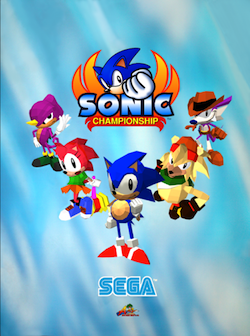
Sonic the Fighters, also known as Sonic Championship on arcade versions outside Japan, is a fighting game developed by Sega AM2. First released in 1996 in arcades on Sega's Model 2 arcade system, Sonic the Fighters pits players in one-on-one battles with a roster of characters from the Sonic the Hedgehog series.

X-Men vs. Street Fighter is a crossover fighting video game developed and published by Capcom. It is Capcom's third fighting game to feature Marvel Comics characters, following X-Men: Children of the Atom and Marvel Super Heroes, and is the first installment in the Marvel vs. Capcom series. As the title suggests, the game includes characters from Marvel's X-Men franchise and the cast from Capcom's Street Fighter series. Originally released as a coin-operated arcade game in 1996, it was ported to the Sega Saturn in 1997 and the PlayStation in 1998.
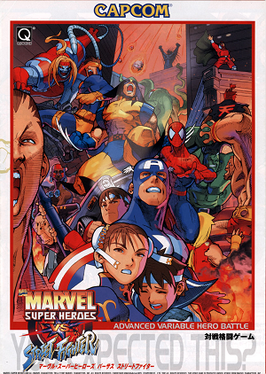
Marvel Super Heroes vs. Street Fighter is a crossover fighting video game developed and published by Capcom. It is the sequel to X-Men vs. Street Fighter and the second installment in the Marvel vs. Capcom series. The game was first released as an arcade game in 1997. It then received ports to the Sega Saturn in 1998 and the PlayStation in 1999.

X-Men: Children of the Atom is an arcade game that was produced by Capcom and released on the CP System II arcade hardware in 1994 in Japan and in 1995 in North America and Europe.

Primal Rage is a fighting game developed and is released by the group of Atari Games to an arcades in the year 1994. The game takes place on a post-apocalyptic version of Earth called "Urth". Players control one of seven large beasts that battle each other to determine the planet's fate. Matches feature many of the conventions of fighting games from the era, including special moves and gory finishing maneuvers. Ports were released for home consoles and personal computers. Efforts to perfectly emulate the arcade original have been unsuccessful due to the use of an unusual copy protection method. Toys, comics, a novel and other merchandise tie-ins were produced. The game sold more than 1.5 million copies.
Marvel Super Heroes is a fighting video game developed by Capcom. Originally released in the arcade in 1995 on the CPS-2 arcade system, it was ported to the Sega Saturn and PlayStation in late 1997. The game, alongside Marvel vs. Capcom: Clash of Super Heroes, was also included in the Marvel vs. Capcom Origins collection, released digitally for the PlayStation 3 and Xbox 360 in September 2012.

Virtua Fighter 2 is a 1994 fighting video game developed by Sega. It is the sequel to Virtua Fighter (1993), and the second game in the Virtua Fighter series. It was created by Sega's Yu Suzuki-headed AM2 and was released for arcades in 1994. Ports were released for the Sega Saturn in 1995 and Microsoft Windows in 1997.
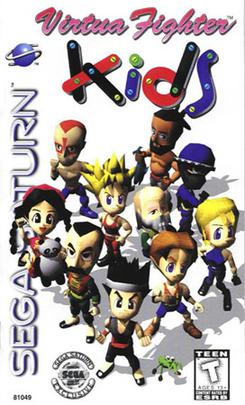
Virtua Fighter Kids is an installment in the Sega AM2 Virtua Fighter fighting game series. A super deformed version of Virtua Fighter 2, it was released in the arcade and on the Sega Saturn in 1996. Unlike Virtua Fighter 2, it was developed on the ST-V board.

Galaxy Fight: Universal Warriors is a fighting game originally developed and published by Sunsoft in 1995 for the Neo-Geo MVS in arcades, and then for the Neo Geo AES console. It was Sunsoft's second fighting game after their 1994 Super Famicom spin-off of their Hebereke series, Sugoi Hebereke, as well as their first side-viewed 2D fighting game.

Power Instinct, released in Japan as Gōketsuji Ichizoku, is a fighting video game series created by Atlus.

Dead or Alive is a 1996 fighting game by Tecmo and the first entry in Team Ninja's long-running Dead or Alive series. It was released first in arcades, followed by home ports for the Sega Saturn in Japan, and later for the PlayStation in all regions.

Rad Mobile is a racing arcade game developed by Sega AM3 and published by Sega. It was first published in Japan in October 1990, followed by an international release for arcades in February 1991. Rad Mobile was Sega's first 32-bit game, using Sega's System 32 arcade system board. It was also the first appearance of Sonic the Hedgehog, who appears as an ornament hanging from the driver's rearview mirror.
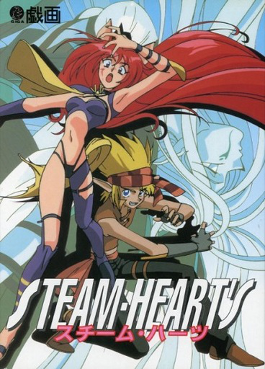
Steam-Heart's is a shoot 'em up and eroge developed by Giga and published by TGL. The story follows two siblings as they fight off a virus that is possessing the people in their world. The game features shooter gameplay paired with ample erotic cutscenes with scantily clad women. Steam-Heart's was initially released on PC-98 personal computers in 1994. It later made its way to the PC Engine Super CD-ROM² System in 1996 and then the Sega Saturn in 1998. All releases have been limited to the Japanese market. Critics generally found the gameplay to be average, with the erotic content being the sole distinguishing feature.

Waku Waku 7 is a 2D fighting game developed and published by Sunsoft initially as an arcade game for the Neo Geo MVS arcade system in 1996 worldwide.

Saturn Bomberman Fight!! is a 1997 maze video game developed and published by Hudson Soft for the Sega Saturn. It is the second Bomberman game for the Saturn, after Saturn Bomberman. It features full 3D graphics unlike previous titles in the series.

Night Warriors: Darkstalkers' Revenge, known in Japan as Vampire Hunter: Darkstalkers' Revenge, is the second game in the Darkstalkers fighting game series, developed and released by Capcom for the arcades in 1995.
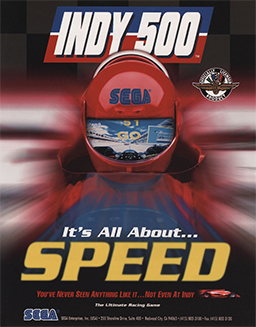
Indy 500 is a 1995 arcade racing game developed by Sega AM1. Based on the IndyCar Series, the game possesses a license from the Indianapolis Motor Speedway, home of the Indianapolis 500, and includes the speedway as one of its courses. Indy 500 was AM1's second game developed using 3D computer graphics and their first to utilize color textures. While planned as a Model 3 arcade system board release, delays in the hardware's completion led to use of the Model 2 instead. A Sega Saturn port was planned, but later canceled. Reception to Indy 500 was mixed, with some critical comparison to other games such as Sega AM2's Daytona USA and Namco's Ace Driver and Rave Racer.
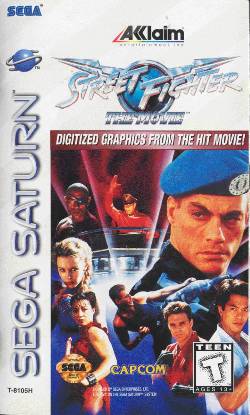
Street Fighter: The Movie is a head-to-head fighting game released for the PlayStation and Sega Saturn in 1995, with the game serving as a North American launch title for the PlayStation. The game is based on the 1994 live-action Street Fighter movie, itself based on the Street Fighter series of fighting games, and uses digitized images of the film's cast as the characters. While it shares its title with the arcade game Street Fighter: The Movie, the home version is not a port but a similar game developed on the same premise. The home version was developed and published by Capcom in Japan and released in North America and Europe by Acclaim Entertainment.

Sky Target is a 1995 arcade game by Sega. A rail shooter featuring a number of planes including the default F-14D Super Tomcat, it is best remembered for its semi-official connection to Sega's earlier hit After Burner. Although never billed as a sequel, its overt similarities to the 1987 classic were nonetheless referenced in official promotional materials and recognized by the media. Plus, it features a revised version of the "After Burner" music theme within its soundtrack.
References
- 1 2 "【次世代機/5月16日】今日は『グルーヴ オン ファイト』の発売21周年!【レトロゲーム】". ゲームドライブ(ゲードラ) - スマホ・アナログ・レトロ・新作ゲーム情報を毎日掲載中!. Retrieved 2019-05-20.
- 1 2 3 "【5月16日のレトロゲーム】今日はSS『グルーヴ オン ファイト』の発売22周年!". Gamedrive. May 19, 2019. Retrieved 2019-05-19.
- 1 2 3 4 Storm, E.; Shidoshi; Rox, Evil (July 1997). "Viewpoint: Groove on Fight". Gamefan . Vol. 5, no. 7. p. 16.
- 1 2 3 4 5 Doc (July 1997). "Made in Japan: Groove on Fight". Japanmania (Superjuegos supplement) (in Spanish). No. 15. Spain. p. 21.
- ↑ "Incoming Games: Spy Fiction". GMR . January 2004. p. 38.
- ↑ Pineda, Rafael Antonio (2018-10-11). "Anime NYC to Host Illustrators Hiroyuki Asada, Range Murata". Anime News Network . Archived from the original on 2018-10-14. Retrieved 2019-05-20.
- ↑ "List of Sega Saturn games that require an external cartridge - Satakore.com". www.satakore.com. Retrieved 2021-02-07.
- ↑ "JAMMA 96: Konami joins coin-op's elite". Next Generation . January 1997. p. 19.
- ↑ "グルーヴ・オン・ファイト 豪血寺一族3". Famitsu . Enterbrain . Retrieved 2019-05-19.
- 1 2 "A Twist in the Tale". Retro: The Collector's Series. United Kingdom: Future Publishing. 2003. p. 105.
- 1 2 Fielder, Joe (2000-05-02). "Groove On Fight (Import) Review". GameSpot. Archived from the original on 2019-03-20. Retrieved 2019-05-19.
- 1 2 "Sega Saturn Soft Review: Groove on Fight". Sega Saturn Magazine (JP) (in Japanese). Vol. 16. Japan. May 16, 1997. p. 173.
- 1 2 Bethino, Baby (August 1997). "Saturn: Groove on Fight". Super GamePower (in Portuguese). No. 41. Brazil: Nova Cultural. p. 24.
- ↑ "Zoom Japan: Groove on Fight". Joypad (in French). No. 66. July 1997. p. 107.
- ↑ "Groove on Fight". Consoles + (in French). No. 67. July 1997.
- ↑ "Saturn: Groove on Fight". Gamers. No. 21. 1998. p. 48.
- 1 2 Naga, Shidoshi (1998). "Video Game Reviews: Groove on Fight". J-Pop . Viz Communications. Archived from the original on 2001-02-16. Retrieved 2020-10-06.
- 1 2 "Sega World". Saturn Power. No. 3. United Kingdom. August 1997. pp. 86–87.
- ↑ "Play: Staff roundup". Play (USA). No. 55. United States of America: Fusion Publishing. July 2006. p. 68.